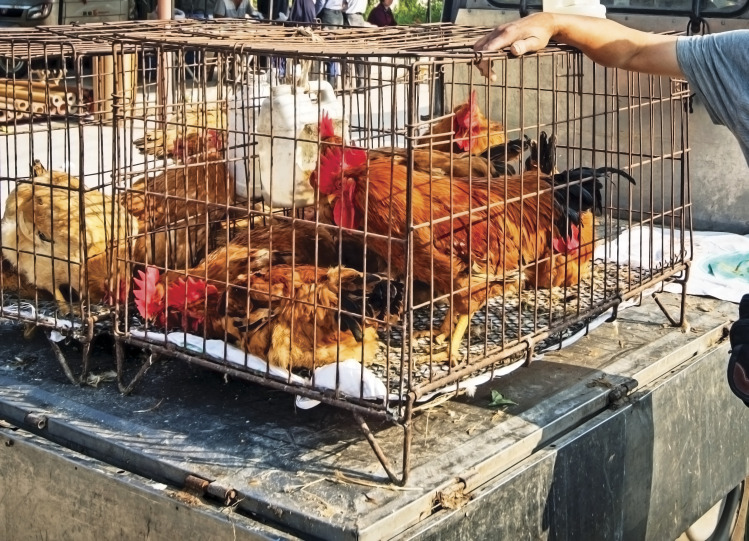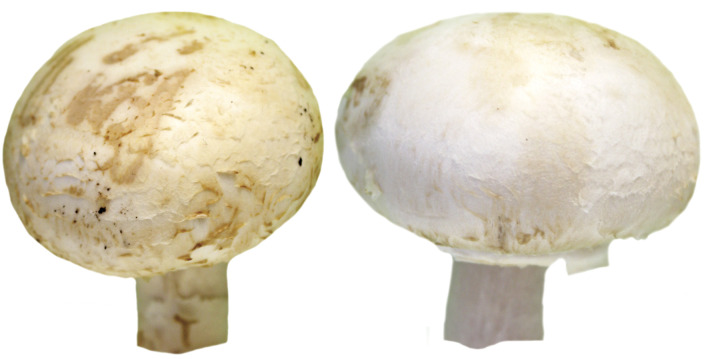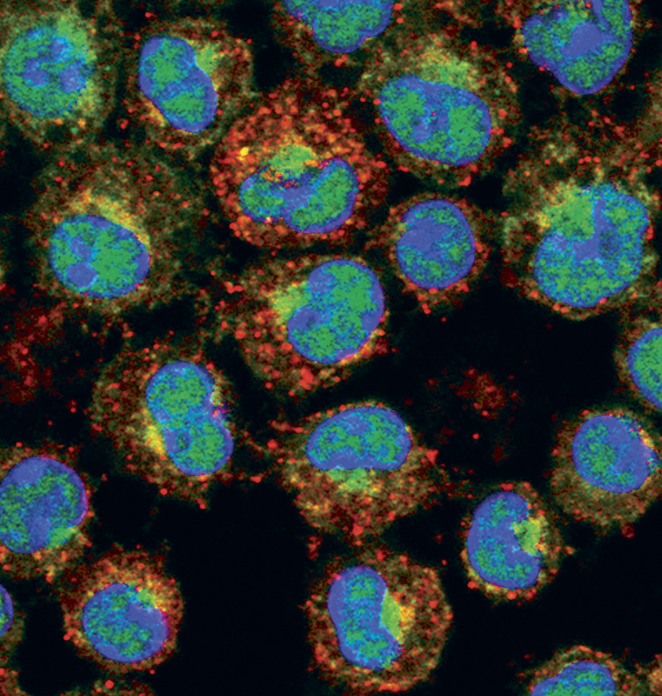Analysis of cuttlebone microstructure
A scanning electron micrograph of the highly porous microstructure of a cuttlebone, with chambered architecture consisting of mineralized vertical walls and horizontal septa.
Cuttlefish are marine mollusks with an ultralightweight internal shell called a cuttlebone, which is mineralized and used for buoyancy. The cuttlebone is primarily composed of the brittle mineral aragonite, yet the structure is highly damage-tolerant and can withstand strong water pressure. Ting Yang, Zian Jia, et al. (pp. 23450–23459) used analytical methods, including synchrotron-based microtomography, in-situ mechanical tests, digital image correlation, and finite element analysis, to examine the microstructure and mechanics of the cuttlebone in the common cuttlefish Sepia officinalis, which can live at depths of 200 m undersea and encounter water pressures of around 20 atm. The authors report that the chambered microstructure of the cuttlebone, which consists of vertical walls and horizontal septa, allows for high specific stiffness—8.4 MNm/kg—and high energy absorption upon loading—4.4 kJ/kg—the result of an optimal waviness gradient evolved by the vertical walls over time. Additionally, the wavy and corrugated walls are nearly as stiff as straight walls but restrict maximum stress to well-defined locations. Biologically inspired cellular ceramics have a range of potential applications in packing, transportation, and infrastructure owing to their desirable mechanical properties. Hence, the authors suggest, analysis of the cuttlebone microstructure could inspire the development of novel, lightweight, and chemically stable ceramic cellular solids. — H.J.
Improving data access diversifies and democratizes science
Empirical research relies on access to data. Although technological innovation has rapidly expanded data output across most scientific disciplines, high fees and usage restrictions often present significant barriers to data access. Focusing on NASA’s Landsat program, which has acquired satellite imagery of Earth since 1972, Abhishek Nagaraj et al. (pp. 23490–23498) found that reduced costs and data access restrictions improve the quantity, quality, and diversity of scientific research. Between 1985 and 1995, the Landsat program was transferred to a private agency and fees for images rose substantially. The government reacquired the program in 1995, and image prices dropped by 43%. Based on statistical analyses of the interval and SCOPUS, a database of abstracts and citations of peer-reviewed literature, the authors found that lowering the cost of Landsat data increased the number of peer-reviewed Landsat publications by a factor of three, while the number of highly cited publications increased sixfold. The analyses also revealed that broadening data access recruited new researchers and expanded the geographical focus of Landsat research, particularly in middle- and low-income regions. According to the authors, easing data access restrictions can help democratize and diversify science. — T.J.
Dynamic viral genetic tuning in humans infected with H7N9
Live chickens for sale in a poultry market in China.
Avian influenza viruses that jump to humans breach the interspecies barrier by evolving variants that replicate efficiently in mammals. Although this transition is key to understanding future influenza outbreaks, little is known about the dynamics that generate key genetic substitutions and how the substitutions correlate with pathogen virulence and patient outcomes. Working with virus-positive samples from poultry as well as people infected with avian influenza, William Liu, Jun Li, Rongrong Zou, Jingcao Pan, et al. (pp. 23807–23814) used deep sequencing to produce viral genomes for the avian influenza virus H7N9, which emerged in 2013 in the Yangtze River delta region of eastern China and has resulted in hundreds of laboratory-confirmed cases with a mortality rate of approximately 40%. The genomes reveal dynamic adaptations that occurred at the interface between poultry and humans. The authors report that the signature E-to-K amino acid change at residue 627 of polymerase basic protein 2 occurred via diverse but longitudinally changing ratios. Dubbed “genetic tuning,” this in vivo dynamic adaptation within hosts correlates with disease severity and fatalities in patients. In addition to providing details about dynamic genetic adaptations that occurred in H7N9 during infection, the study also suggests that patients infected with avian-origin viruses may need to be tested for adaptations while they are infected, according to the authors. — T.J.
How helper bacteria protect white button mushrooms
Symptoms of brown blotch disease in white button mushroom Agaricus bisporus caused by P. tolaasii (Left) can be prevented by addition of helper bacteria M. tolaasinivorans (Right).
The bacterial pathogen Pseudomonas tolaasii causes brown blotch disease in white button mushrooms, an important food source. Helper bacterial strains Mycetocola tolaasinivorans and Mycetocola lacteus appear to protect the mushrooms from the tolaasin toxin, but the underlying mechanism is unclear. Christian Hertweck et al. (pp. 23802–23806) report that helper bacteria defend mushrooms against the pathogen by enzymatically disabling the toxin as well as the pathogen’s motility. When the authors grew the helper bacteria together with the pathogen, they found that toxin production was reduced and the pathogen’s ability to swarm was hampered. Two different molecules that contain a ring-like chemical structure confer motility and toxicity on P. tolaasii. The authors isolated one of the enzymes underlying the helper bacteria’s protective action by analyzing fractions of Mycetocola cell lysate. Next, the authors analyzed the specificity of the enzyme, a lactonase, and found that it neutralizes tolaasin through lipopeptide cleavage, snipping the ring-shaped peptide into a linear structure. According to the authors, understanding how helper bacteria prevent infection in important agricultural species could help develop biocontrol strains for use in food production as well as medicine. — T.H.D.
How brain flexibility emerges in infants
Cognitive flexibility is the ability to switch between mental processes in response to different task demands. This attribute is positively associated with reading ability, academic success, resilience to stress, and creativity, and negatively associated with risk of various neurological and psychiatric disorders. To examine the emergence of neural flexibility, which is thought to underlie cognitive flexibility, Weiyan Yin et al. (pp. 23904–23913) used MRI to measure brain activity during sleep up to seven times in 52 typically developing infants under the age of 2 years. The authors define neural flexibility as the frequency with which a brain region changes its role or allegiance from one functional network to another. Neural flexibility increases with age across the whole brain, specifically in regions that control movement, potentially enabling infants to learn motor skills. Neural flexibility also increases with age in regions involved in higher-level cognitive processes such as attention, memory, and response inhibition, indicating continuing development of these networks. The age-related increase in neural flexibility is highest in brain regions implicated in cognitive flexibility in adults, suggesting that cognitive flexibility may begin to develop during the first two years of life. According to the authors, the findings provide insights into the development of higher-level brain functions. — J.W.
Perinatal androgens and sex bias in mast cell disorders
Immunoflourescence image of mast cells.
A critical part of the innate immune system, mast cells (MCs) are involved in inflammation and associated with autoimmune diseases and chronic pain. Although MC-associated disorders are reportedly more prevalent in women than men, the biological underpinnings remain unclear. Noting that sex bias in immune disorders exists in both children and adults, Emily Mackey et al. (pp. 23751–23761) used a mouse model to show that MC-mediated anaphylactic responses develop prior to puberty in both males and females and exhibit sex differences that persist into adulthood. Specifically, the authors found that prepubertal males experienced lower serum histamine levels and anaphylaxis severity, compared with females, and that the depressed anaphylaxis severity was due to naturally higher levels of perinatal androgens. Furthermore, females who received male perinatal androgen in utero developed MCs that mediated histamine levels and reduced anaphylaxis severity similar to males. Additionally, the authors report that MC-deficient mutants with engrafted adult male, female, or perinatally androgenized female MCs produced MC-mediated anaphylaxis that matched the sex of the donor, rather than that of the host. The findings suggest that sex bias in MC-associated diseases may arise from early differences in perinatal androgens, according to the authors. — T.J.
Protecting against spaceflight-induced muscle and bone loss
The smaller mouse is wild type; the larger mouse is genetically modified to lack myostatin and, as a result, has larger muscles.
The simultaneous loss of bone and skeletal muscle is a major challenge facing astronauts on long-term missions, as well as individuals with disuse atrophy from being elderly, bedridden, or wheelchair-bound. One potential preventive or therapeutic strategy is to target the myostatin/activin A signaling pathway, a cellular mechanism that regulates bone density and skeletal muscle mass. Se-Jin Lee et al. (pp. 23942–23951) tested this strategy in mice exposed to microgravity at the International Space Station for 33 days, compared with mice maintained on Earth. The authors inhibited myostatin/activin A signaling through injections of the activin type IIB (ACVR2B) decoy receptor. Treatment with the ACVR2B receptor led to similar increases in muscle and bone mass in microgravity-exposed and Earth-bound mice, when compared with untreated control mice. Moreover, mice treated with the ACVR2B receptor after returning to Earth showed enhanced recovery of muscle mass, compared with untreated control mice that had returned from microgravity. Taken together, the findings suggest that inhibiting myostatin/activin A signaling could simultaneously protect against muscle and bone loss during spaceflight and promote recovery of muscle and bone mass after return to Earth. — J.W.
Spatially embedded social networks and nonstandard epidemic dynamics
Epidemic models typically conceptualize disease propagation as an expanding tree-like network of contacts. Although this approach accurately captures biological transmission processes, it fails to explicitly account for the influence of social networks on human travel. David Haw, Rachael Pung, et al. (pp. 23636–23642) present a spatially embedded network model of disease transmission, which can be tuned using different assumptions about how people travel, to reflect the effects of large social network structures on disease dynamics. The model uses a statistical rewiring algorithm to yield a distribution of commuting distances consistent with a gravity-like movement function. By varying the strength of the gravity-like parameter, the study reveals how shifts toward shorter commuting distances can lead to an ongoing saturation of susceptible populations, resulting in outbreaks with lower and later epidemic peaks that lack the typical exponential growth phase of simpler models. Combined with other results, this finding demonstrates that the model can reproduce a range of epidemic profiles, including those that exhibit nonstandard patterns. Originally conceived to explain Ebola outbreak dynamics in West Africa, this work illustrates the important role of interhousehold contacts in disease transmission, according to the authors. — T.J.







